人教版B8 Unit 5 Meeting your ancestors Workbook课件49张
文档属性
| 名称 | 人教版B8 Unit 5 Meeting your ancestors Workbook课件49张 | 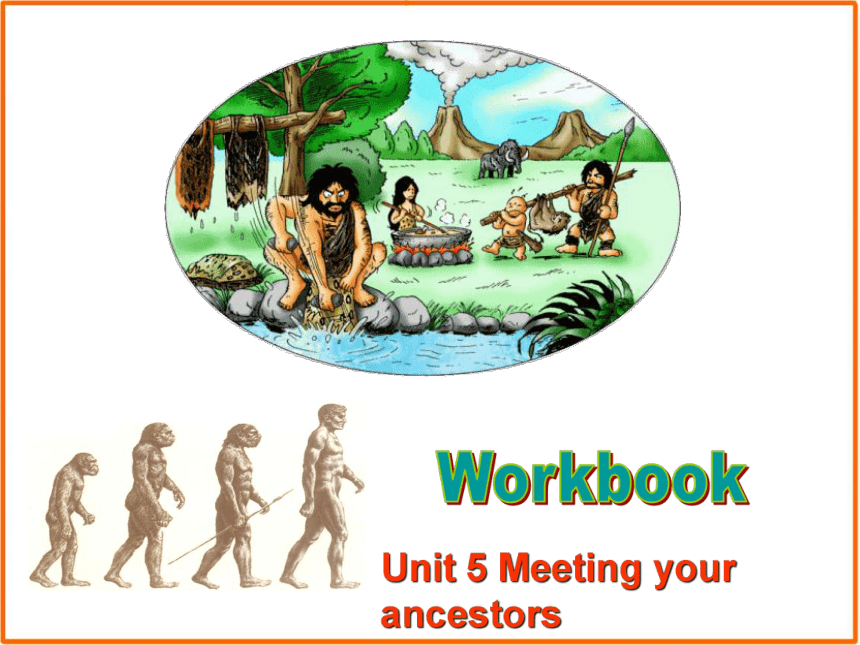 | |
| 格式 | zip | ||
| 文件大小 | 3.1MB | ||
| 资源类型 | 教案 | ||
| 版本资源 | 人教版(新课程标准) | ||
| 科目 | 英语 | ||
| 更新时间 | 2015-06-03 16:20:24 | ||
图片预览

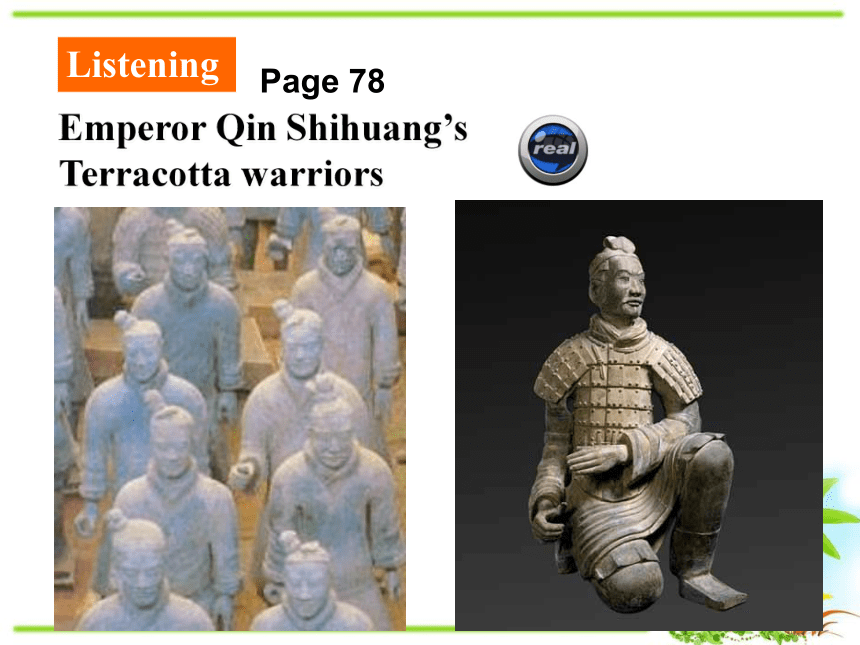
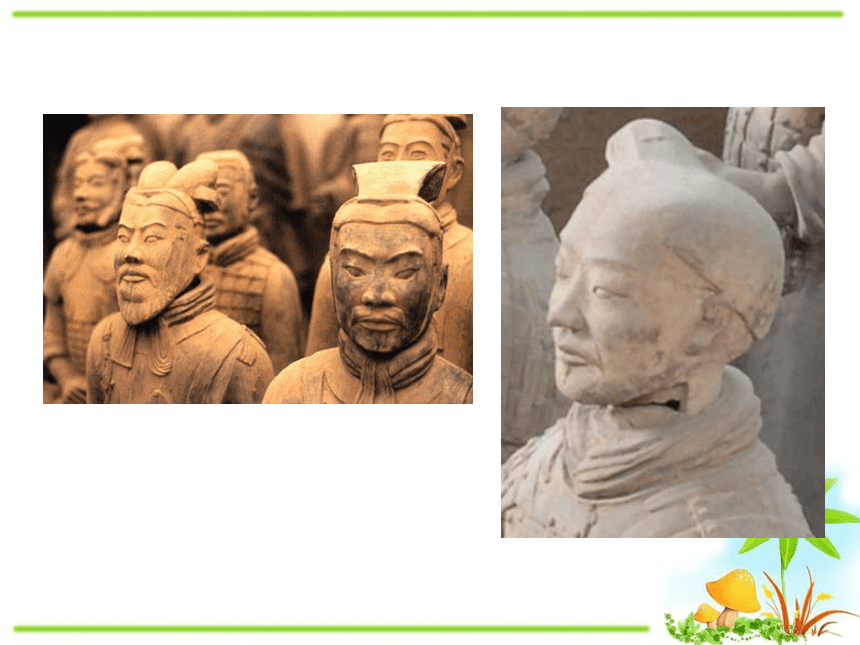
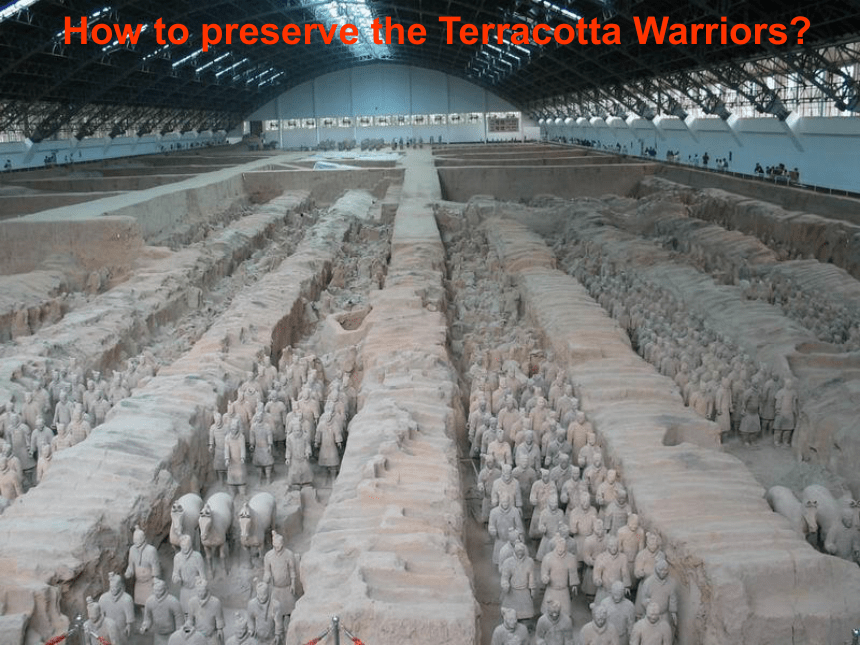
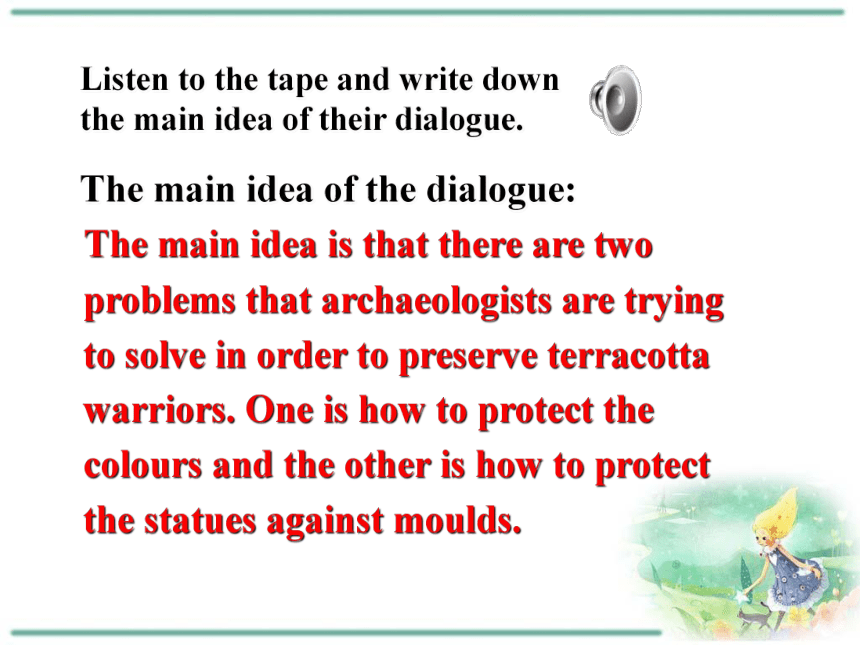
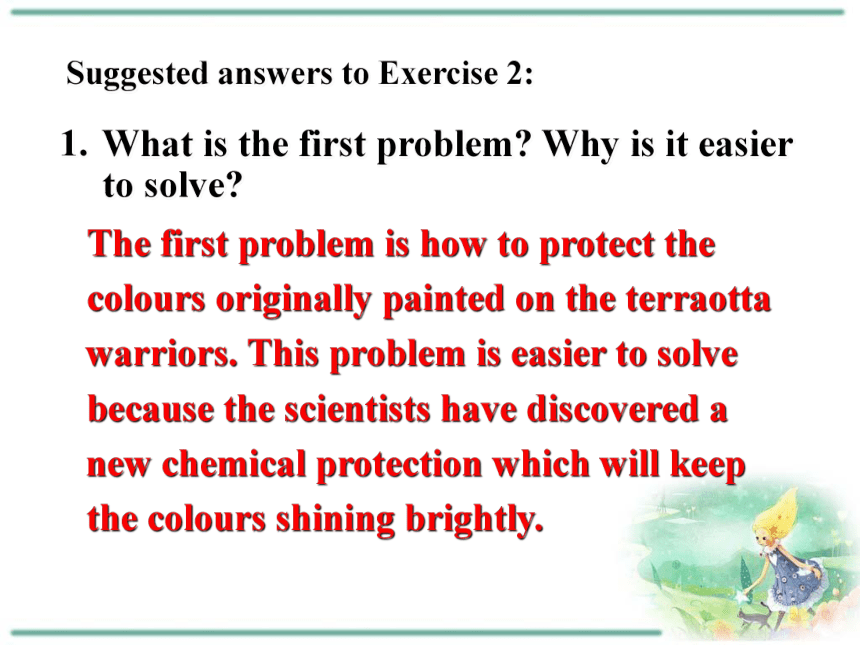
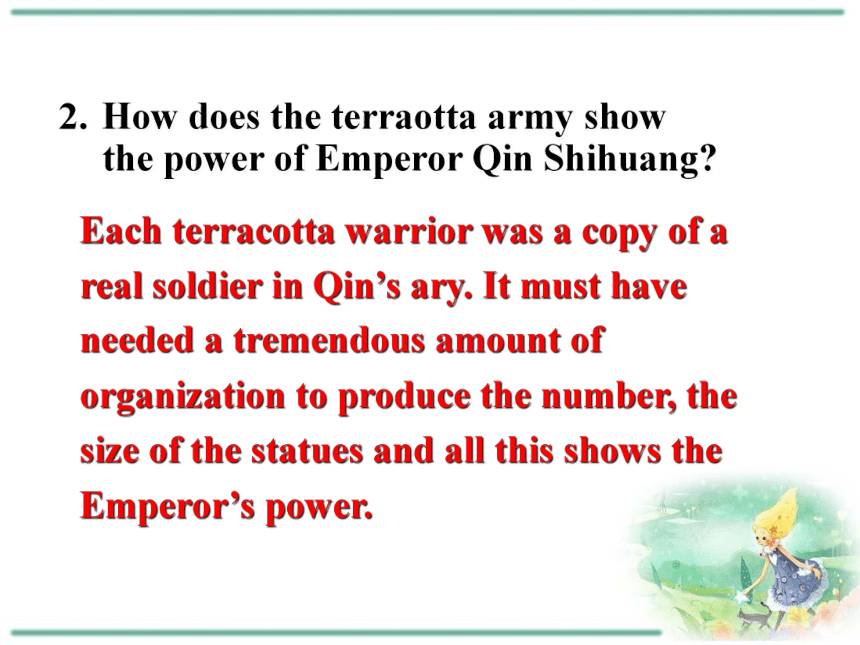
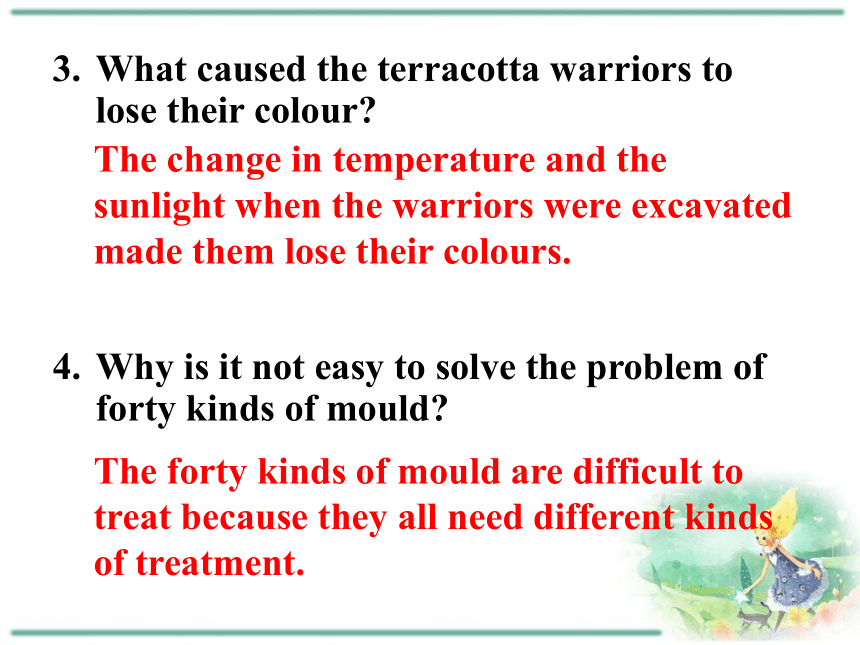
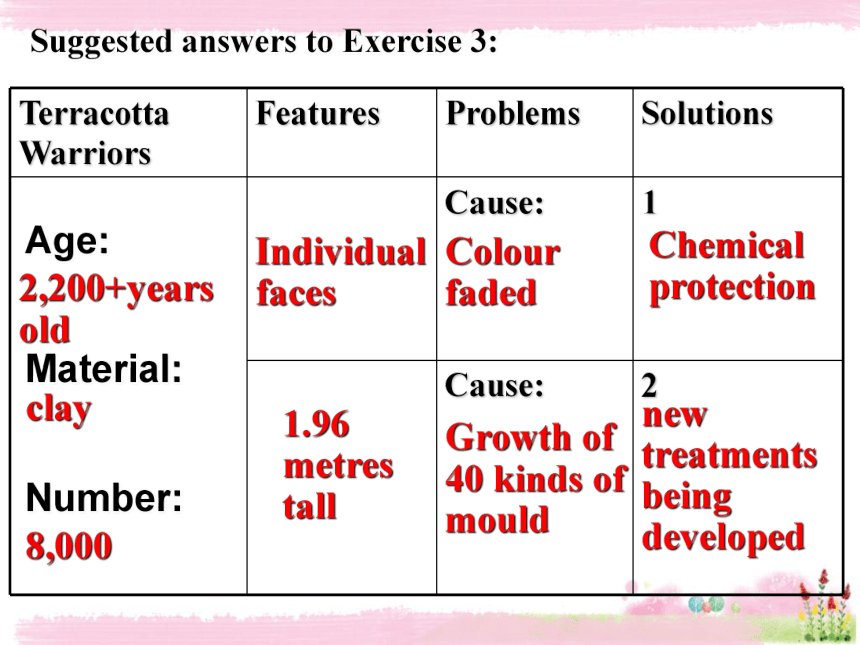
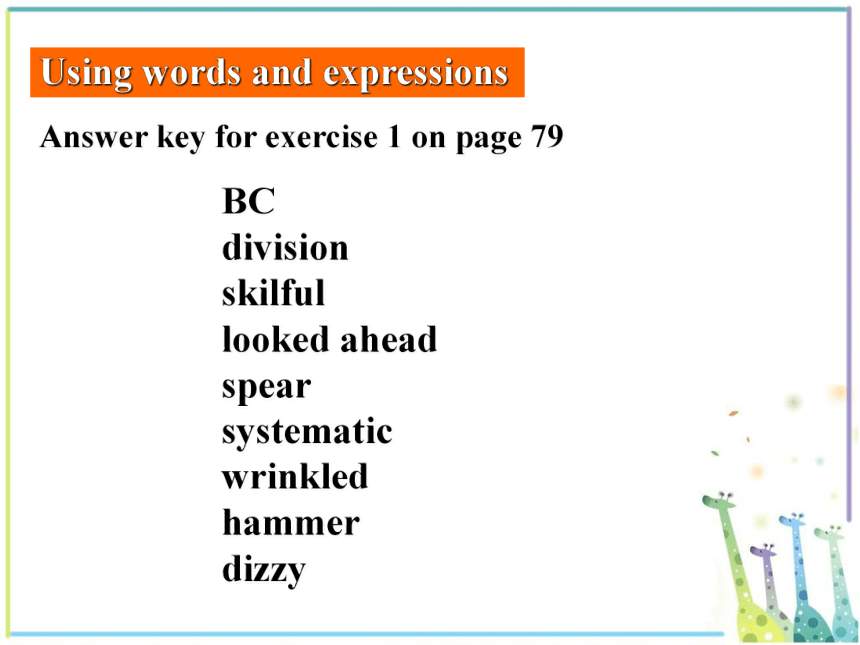
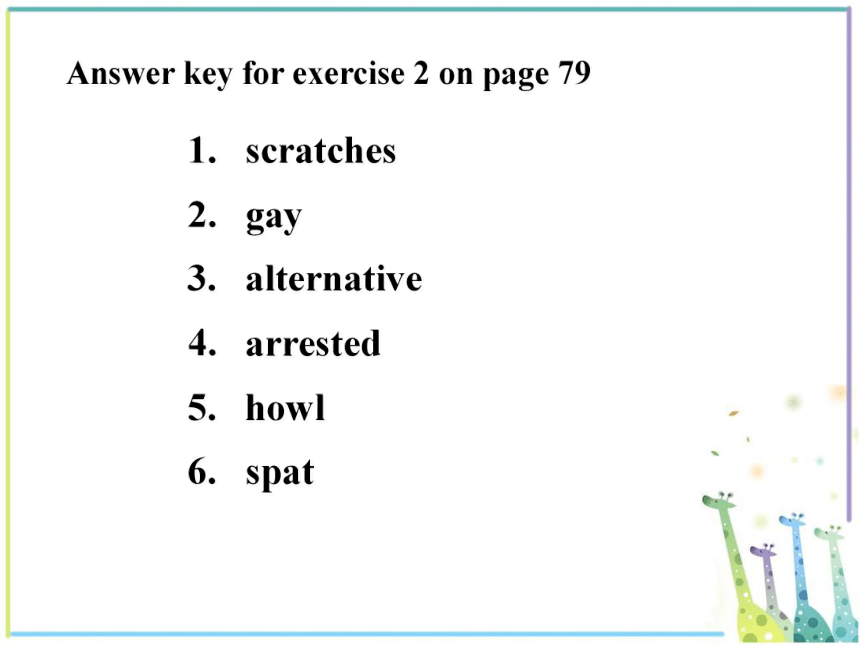
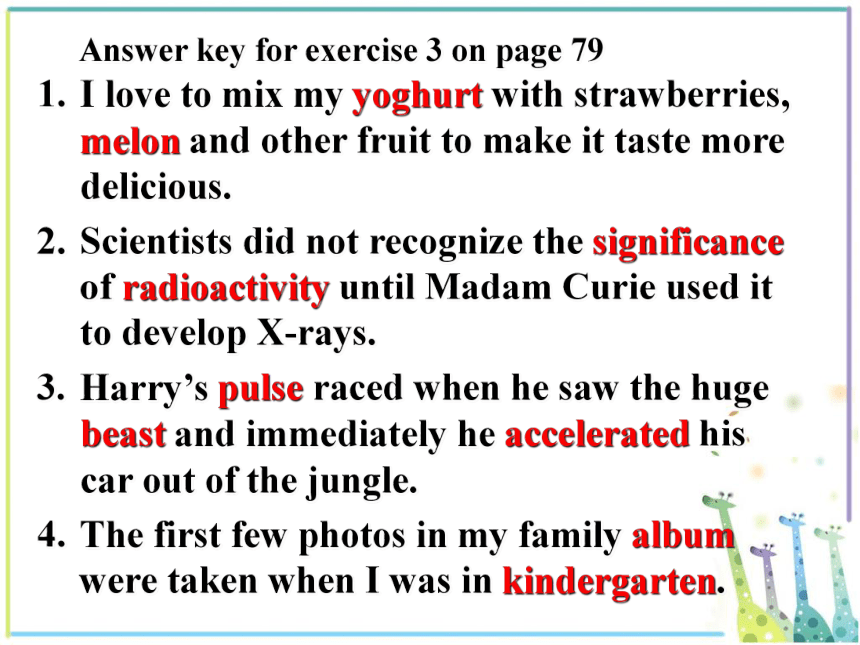
文档简介
课件49张PPT。Unit 5 Meeting your ancestors WorkbookEmperor Qin Shihuang’s Terracotta warriorsListeningPage 78How to preserve the Terracotta Warriors?The main idea of the dialogue:The main idea is that there are two problems that archaeologists are trying to solve in order to preserve terracotta warriors. One is how to protect the colours and the other is how to protect the statues against moulds.Listen to the tape and write down the main idea of their dialogue.Suggested answers to Exercise 2:The first problem is how to protect the colours originally painted on the terraotta warriors. This problem is easier to solve because the scientists have discovered a new chemical protection which will keep the colours shining brightly.What is the first problem? Why is it easier to solve?Each terracotta warrior was a copy of a real soldier in Qin’s ary. It must have needed a tremendous amount of organization to produce the number, the size of the statues and all this shows the Emperor’s power.How does the terraotta army show the power of Emperor Qin Shihuang?The change in temperature and the sunlight when the warriors were excavated made them lose their colours.
The forty kinds of mould are difficult to treat because they all need different kinds of treatment.What caused the terracotta warriors to lose their colour?
Why is it not easy to solve the problem of forty kinds of mould?Colour fadedGrowth of 40 kinds of mouldChemical protectionnew treatments being developedIndividual faces1.96 metres tallAge:
Material:
Number:2,200+years oldclay8,000Suggested answers to Exercise 3:Using words and expressionsBC
division
skilful
looked ahead
spear
systematic
wrinkled
hammer
dizzyAnswer key for exercise 1 on page 79Answer key for exercise 2 on page 79scratches
gay
alternative
arrested
howl
spatAnswer key for exercise 3 on page 79I love to mix my yoghurt with strawberries, melon and other fruit to make it taste more delicious.
Scientists did not recognize the significance of radioactivity until Madam Curie used it to develop X-rays.
Harry’s pulse raced when he saw the huge beast and immediately he accelerated his car out of the jungle.
The first few photos in my family album were taken when I was in kindergarten.I always knew that she was fed up with being a receptionist.
The audience applauded the performance of the skillful skateboarding athletes for a couple of minutes.
The expert said the use of tobacco dated back to 1000BC.
I think you need to delete unnecessary repetition from your article and check your punctuation before you hand it in.Using structuresAnswer key for Exercise 1:What have you been doing lately?
Oh, really? Did you find it valuable?
Will you continue it for a second year then?
Don’t they offer some scholarships if you’re a good student?Answer key for Exercise 2:has increased,
were discovered,
would be,
had been put/placed,
became,
comes, puts,
was…surprising,
were taken,
were,
seems,
will remainListening taskI think the ancient Egyptians believed: the spirit of one’s body went on the journey to the afterlife. They believed everyone must be tested to see if they had led a good life.Page 81Answer key for Exercise 2:F
T
T
T
F
TWhy did one person take so many artifacts and the other so few?What kind of life did the rich person want in the afterlife?Because a rich person had many more goods to take with him/her than a poor person.The same as in his lifetime.Suggested answers to Exercise 3:They both believed in life after death.
They both had their bodies preserved.
They both had goods in the grave for the journey to the afterlife.There were many more goods in the rich person’s grave than in the poor person’s.
The rich person was buried in a special building, but the poor person was not.
The rich person had guidebooks for the journey to the afterlife, but the poor person did not.Pharaoh Tutankhamun was the
most famous of all pharaohs but very
unimportant as a ruler as his rule was
so short. He ruled for about 8 or 9 years
from 1334 to 1325 BC. So we know more
about him after his death than we do Reading Task (P82)NOTE: Pharaoh Tutankhamun about his rule when he was alive.
The Egyptians believed in life after death.
So they got all the goods they wanted to
have with them in the next life buried in
their tomb. The richer the person, the
greater the number of goods. As
Tutankhamun was a pharaoh, his tomb
was filled with many wonderful treasures.It also contained statues of gods that would
protect his tomb from evil spirits or thieves
who might steal his treasures. The walls of
the tomb, too, were covered with spells to
preserve the pharaoh till he got safely to
the Hall of Judgement. In the same way
his body inside its three coffins was
protected by four goddesses of the dead. By the tomb was a box containing four jars.
They held the internal organs of the dead
pharaoh, which were removed when he was
turned into a mummy. First his brain was
taken out of his head through his nose.
Then his organs were removed and put
into the jars. Only his heart was left inside the body. Finally
his body was covered in a special salt and
left for forty days to “dry”. After this time
the body was a mummy and was ready to
be wrapped up and buried.
As well as the body there were instructions
in the coffin on how to make the journey
to the afterlife.Answer key for Exercise 1 on Page 83Two statues/Black Wearing gold shoes and carrying royal insigniaChairsGoldGolden With heads of animals and gods/Flowers // /Vases // With beautiful flower designsBoxes /Black /Chests /White /Seat /Golden /CartGold Golden /1. How did they know whose tomb it was?
They read his name on a black box.
2. Why do you think they thought these
things came from another civilization?
Because they were so strange and
wonderful---more wonderful than
anyone could imagine.Answer key for Exercise 23. Why did Carter get excited when he
noticed the door to the tomb was still
fastened?
Because it meant that the tomb had
not been opened by thieves.1. I would have to lock the tomb securely
so that thieves could not steal the finds.
2. I would have to lock the tomb securely
so that the sunlight and temperature
would not affect the finds in the tomb.
Otherwise the finds may be spoiled.Suggested answers to Exercise 33. I would have to lock the tomb securely so that I could record all the finds carefully, and I would not want any of the finds to be moved.wall paintingSpeaking Task on P84These wall paintings are from the tomb of
a nobleman named Nebamun. Nebamun’s
tomb was built around 1400 B.C. near
the town of Thebes(底比斯, 埃及的古都). In pairs, discuss what you can find from
the wall painting and fill in the chart below.Fish, meat, vegetables and fruitChairs but no tables; food is served; entertainment at the same time as the mealGuests wear long floating dresses with large decorated collars; servants and dancers wear very littleServants wash hands of the guests before serving the food DancersGuests: women
Servants: men
Dancers: girlsPyramids Look at the pictures on P85 and
discuss the questions below them.
The order should be BAC.
The earliest pyramid is B, which is
called step pyramid. It was built during
the Third Dynasty (2800 BC). Step
pyramid is generally considered theWriting first tomb in Egypt to be built entirely of stone anywhere in the world.
The second is A. It was built in about 2,550
B. C., King Khufu, the second pharaoh of the
fourth dynasty, commissioned the building of
his tomb at Giza. According to archaeologists,
the top of the Khufu pyramid is in a way ripped
off, which is in common with the first picture.Then the third one is the third picture. It is
called bent pyramid, which was built for
Khafre, the fourth pharaoh of the fourth dynasty.
The bent pyramid at Dahshur shows us that the
ancient Egyptians experimented a lot with the
slope of the pyramids. In the middle of
construction the builders must have decided that the slope
of the building was too steep to continue. Thus,
the top half of the pyramid has a different slope.
The pyramid had sloping sides so that the dead
pharaoh could climb to the sky and live forever.
The pyramid represented the rays of the sun.A sample version:I think the chronological order of bulling
the pyramids is B-A-C. The earliest
pyramid is B, which is called step
pyramid. It was built during the Third
Dynasty (2800 B.C.). Step pyramid is
generally considered the first tomb in
Egypt to be built entirely of stone. The
second is A. It was built about 2,550 BC, King Khufu, the second pharaoh of the fourth dynasty, commissioned the building of his tomb at Giza. Then the third one is C. It is called bent pyramid, which was built for Khafre, the fourth pharaoh of the fourth dynasty. The bent pyramid at Dahshur shows us that the ancient Egyptians experimented a lot with the slope of the pyramids. In the middle of construction the builders must have decided that the slope of the building was too steep to continue. Thus, the top half of the pyramid has a different slope.All the three pyramids come to a point at
the top. As its name suggests, step pyramid
is a series of six levels of stone decreasing
in size as they ascend to about 200 feet (60
meters) in height. Egyptologists have
developed many theories about why the
tombs of the early pharaohs were built
in the pyramid shape. Variable reasons are possible: the pyramid represented the first land to appear at the beginning of time --- a hill called Ben-Ben, the pyramid had sloping sides so that the dead pharaoh could symbolically climb to the sky and live forever and the pyramid represented the rays of the sun.HomeworkFinish the Exs. In Best English on
page 78-79.
The forty kinds of mould are difficult to treat because they all need different kinds of treatment.What caused the terracotta warriors to lose their colour?
Why is it not easy to solve the problem of forty kinds of mould?Colour fadedGrowth of 40 kinds of mouldChemical protectionnew treatments being developedIndividual faces1.96 metres tallAge:
Material:
Number:2,200+years oldclay8,000Suggested answers to Exercise 3:Using words and expressionsBC
division
skilful
looked ahead
spear
systematic
wrinkled
hammer
dizzyAnswer key for exercise 1 on page 79Answer key for exercise 2 on page 79scratches
gay
alternative
arrested
howl
spatAnswer key for exercise 3 on page 79I love to mix my yoghurt with strawberries, melon and other fruit to make it taste more delicious.
Scientists did not recognize the significance of radioactivity until Madam Curie used it to develop X-rays.
Harry’s pulse raced when he saw the huge beast and immediately he accelerated his car out of the jungle.
The first few photos in my family album were taken when I was in kindergarten.I always knew that she was fed up with being a receptionist.
The audience applauded the performance of the skillful skateboarding athletes for a couple of minutes.
The expert said the use of tobacco dated back to 1000BC.
I think you need to delete unnecessary repetition from your article and check your punctuation before you hand it in.Using structuresAnswer key for Exercise 1:What have you been doing lately?
Oh, really? Did you find it valuable?
Will you continue it for a second year then?
Don’t they offer some scholarships if you’re a good student?Answer key for Exercise 2:has increased,
were discovered,
would be,
had been put/placed,
became,
comes, puts,
was…surprising,
were taken,
were,
seems,
will remainListening taskI think the ancient Egyptians believed: the spirit of one’s body went on the journey to the afterlife. They believed everyone must be tested to see if they had led a good life.Page 81Answer key for Exercise 2:F
T
T
T
F
TWhy did one person take so many artifacts and the other so few?What kind of life did the rich person want in the afterlife?Because a rich person had many more goods to take with him/her than a poor person.The same as in his lifetime.Suggested answers to Exercise 3:They both believed in life after death.
They both had their bodies preserved.
They both had goods in the grave for the journey to the afterlife.There were many more goods in the rich person’s grave than in the poor person’s.
The rich person was buried in a special building, but the poor person was not.
The rich person had guidebooks for the journey to the afterlife, but the poor person did not.Pharaoh Tutankhamun was the
most famous of all pharaohs but very
unimportant as a ruler as his rule was
so short. He ruled for about 8 or 9 years
from 1334 to 1325 BC. So we know more
about him after his death than we do Reading Task (P82)NOTE: Pharaoh Tutankhamun about his rule when he was alive.
The Egyptians believed in life after death.
So they got all the goods they wanted to
have with them in the next life buried in
their tomb. The richer the person, the
greater the number of goods. As
Tutankhamun was a pharaoh, his tomb
was filled with many wonderful treasures.It also contained statues of gods that would
protect his tomb from evil spirits or thieves
who might steal his treasures. The walls of
the tomb, too, were covered with spells to
preserve the pharaoh till he got safely to
the Hall of Judgement. In the same way
his body inside its three coffins was
protected by four goddesses of the dead. By the tomb was a box containing four jars.
They held the internal organs of the dead
pharaoh, which were removed when he was
turned into a mummy. First his brain was
taken out of his head through his nose.
Then his organs were removed and put
into the jars. Only his heart was left inside the body. Finally
his body was covered in a special salt and
left for forty days to “dry”. After this time
the body was a mummy and was ready to
be wrapped up and buried.
As well as the body there were instructions
in the coffin on how to make the journey
to the afterlife.Answer key for Exercise 1 on Page 83Two statues/Black Wearing gold shoes and carrying royal insigniaChairsGoldGolden With heads of animals and gods/Flowers // /Vases // With beautiful flower designsBoxes /Black /Chests /White /Seat /Golden /CartGold Golden /1. How did they know whose tomb it was?
They read his name on a black box.
2. Why do you think they thought these
things came from another civilization?
Because they were so strange and
wonderful---more wonderful than
anyone could imagine.Answer key for Exercise 23. Why did Carter get excited when he
noticed the door to the tomb was still
fastened?
Because it meant that the tomb had
not been opened by thieves.1. I would have to lock the tomb securely
so that thieves could not steal the finds.
2. I would have to lock the tomb securely
so that the sunlight and temperature
would not affect the finds in the tomb.
Otherwise the finds may be spoiled.Suggested answers to Exercise 33. I would have to lock the tomb securely so that I could record all the finds carefully, and I would not want any of the finds to be moved.wall paintingSpeaking Task on P84These wall paintings are from the tomb of
a nobleman named Nebamun. Nebamun’s
tomb was built around 1400 B.C. near
the town of Thebes(底比斯, 埃及的古都). In pairs, discuss what you can find from
the wall painting and fill in the chart below.Fish, meat, vegetables and fruitChairs but no tables; food is served; entertainment at the same time as the mealGuests wear long floating dresses with large decorated collars; servants and dancers wear very littleServants wash hands of the guests before serving the food DancersGuests: women
Servants: men
Dancers: girlsPyramids Look at the pictures on P85 and
discuss the questions below them.
The order should be BAC.
The earliest pyramid is B, which is
called step pyramid. It was built during
the Third Dynasty (2800 BC). Step
pyramid is generally considered theWriting first tomb in Egypt to be built entirely of stone anywhere in the world.
The second is A. It was built in about 2,550
B. C., King Khufu, the second pharaoh of the
fourth dynasty, commissioned the building of
his tomb at Giza. According to archaeologists,
the top of the Khufu pyramid is in a way ripped
off, which is in common with the first picture.Then the third one is the third picture. It is
called bent pyramid, which was built for
Khafre, the fourth pharaoh of the fourth dynasty.
The bent pyramid at Dahshur shows us that the
ancient Egyptians experimented a lot with the
slope of the pyramids. In the middle of
construction the builders must have decided that the slope
of the building was too steep to continue. Thus,
the top half of the pyramid has a different slope.
The pyramid had sloping sides so that the dead
pharaoh could climb to the sky and live forever.
The pyramid represented the rays of the sun.A sample version:I think the chronological order of bulling
the pyramids is B-A-C. The earliest
pyramid is B, which is called step
pyramid. It was built during the Third
Dynasty (2800 B.C.). Step pyramid is
generally considered the first tomb in
Egypt to be built entirely of stone. The
second is A. It was built about 2,550 BC, King Khufu, the second pharaoh of the fourth dynasty, commissioned the building of his tomb at Giza. Then the third one is C. It is called bent pyramid, which was built for Khafre, the fourth pharaoh of the fourth dynasty. The bent pyramid at Dahshur shows us that the ancient Egyptians experimented a lot with the slope of the pyramids. In the middle of construction the builders must have decided that the slope of the building was too steep to continue. Thus, the top half of the pyramid has a different slope.All the three pyramids come to a point at
the top. As its name suggests, step pyramid
is a series of six levels of stone decreasing
in size as they ascend to about 200 feet (60
meters) in height. Egyptologists have
developed many theories about why the
tombs of the early pharaohs were built
in the pyramid shape. Variable reasons are possible: the pyramid represented the first land to appear at the beginning of time --- a hill called Ben-Ben, the pyramid had sloping sides so that the dead pharaoh could symbolically climb to the sky and live forever and the pyramid represented the rays of the sun.HomeworkFinish the Exs. In Best English on
page 78-79.
